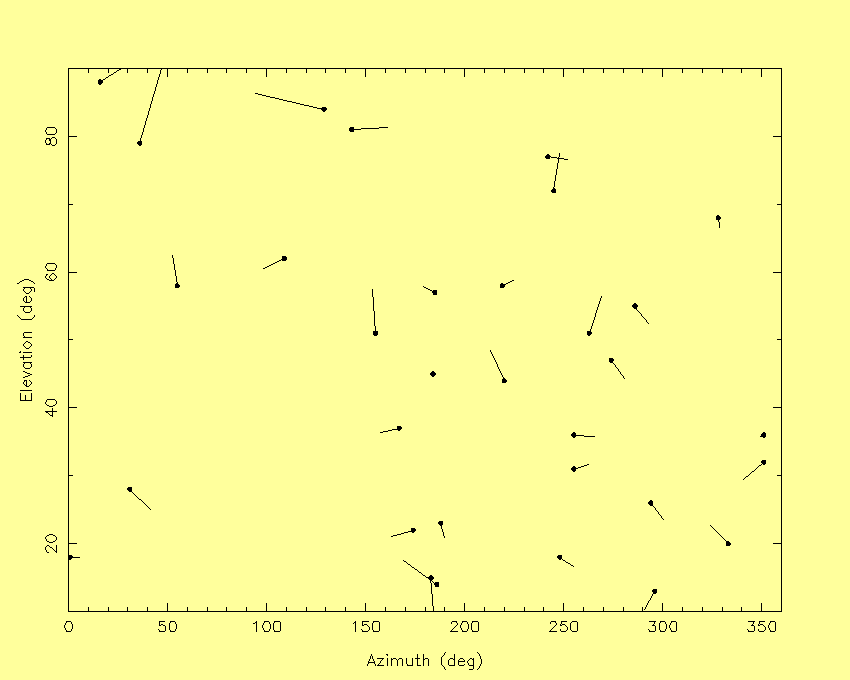WHT tracking
Without autoguiding (i.e. open-loop), the WHT typically tracks with accuracy
~ 1 arcsec per 10 minutes in both azimuth and elevation.
On at least this timescale, the drift is steady and monotonic.

The vectors on the above plot indicate the measured direction and size of drift when
open-loop tracking, as a function of star azimuth and elevation.
A vector whose plotted length equals the separation of 10-deg ticks on the elevation axis
indicates a measured drift rate of 10 arcsec per 30 minutes (i.e. 3.3 arcsec per
10 minutes).
The median drift is 1.1 arcsec per 10 minutes.
There's no evidence of a dependence on azimuth or elevation, except that
tracking is significantly poorer at the highest
elevations (>~ 80 deg), where tracking in azimuth is more rapid.
(A movement of 1 arcsec on the sky, in the azimuth direction,
corresponds to a change in telescope azimuth of 1 / (cos(elevation)) arcsec.)
The plotted measurements were made in 2014 - 2016
(usually when conditions
were unsuitable for science observing, or for other tests), by
monitoring the open-loop movement of a star on the acquisition camera or autoguider.
The raw data are reproduced below, together with earlier measurements
made during 1991 - 2006.
Measured tracking drifts
Columns 2 and 3 give the azimuth and elevation being tracked
(without autoguiding), column 4 is the time spent tracking,
and columns 5 and 6 give the adjustment in azimuth
(arcsec on sky) and elevation required
after that time to bring the star back to its original position
on the camera. The data for each night are in order of increasing elevation.
Date AZ EL Time DAZ DEL
yyyy mm dd deg deg mins " "
(1) (2) (3) (4) (5) (6)
2016 01 31 296 13 12 0.6 1.1
2016 01 31 351 36 12 0.2 0.1
2016 01 31 274 47 16 -1.0 1.4
2016 01 31 242 77 16 -1.5 0.2
2016 01 30 186 14 13 2.1 -1.5
2016 01 30 174 22 16 1.7 0.5
2016 01 30 167 37 13 1.2 0.3
2016 01 30 220 44 18 1.2 -2.7
2016 01 30 155 51 13 0.2 -2.8
2016 01 30 328 68 16 -0.1 0.8
2016 01 30 36 79 12 -1.8 -6.2
2016 01 29 263 51 10 -0.6 -1.8
2016 01 22 183 15 11 -0.2 2.4
2016 01 22 248 18 13 -0.9 0.6
2016 01 22 333 20 12 1.0 -1.1
2016 01 22 188 23 10 -0.2 0.7
2016 01 22 351 32 12 1.2 1.0
2016 01 22 255 36 11 -1.1 0.1
2016 01 22 184 45 16 0.0 0.0
2016 01 22 219 58 11 -0.6 -0.3
2016 01 22 245 72 11 -0.3 -2.0
2016 01 22 143 81 11 -1.9 -0.1
2014 05 19 01 18 14 -0.6 0.0
2014 05 19 294 26 16 -1.0 1.3
2014 05 19 31 28 10 -1.0 1.0
2014 05 19 255 31 10 -0.7 -0.2
2014 05 19 286 55 23 -1.5 2.0
2014 05 19 185 57 13 0.7 -0.4
2014 05 19 55 58 12 0.3 -1.8
2014 05 19 109 62 10 1.0 0.5
2014 05 19 129 84 13 4.3 -1.0
2014 05 19 16 88 7 -11.0 -7.0 close to zenith blind spot
2006 05 12 191 58 15 1.4 1.5
2006 05 12 197 68 15 0.4 1.4
2006 05 10 29 15 0.1 -0.8
2006 05 10 66 15 0.0 -1.9
2005 11 20 21 58 15 1.3 2.3
2005 09 32 66 30 0.0 1.4
1999 09 24 170 30 15 0.4 0.9
1999 09 24 170 40 25 0.8 1.6
1999 09 24 150 50 20 0.0 2.9
1999 09 24 180 50 20 0.2 1.4
1999 09 24 200 60 20 < 0.3 < 0.3
1999 09 24 180 80 35 2.4 3.0
1998 01 15 hi 15 ~ 3 ~ 3
1991 01 23 ~60 30 < 1 < 1
1991 01 23 ~60 30 < 1 < 1
For the measurements prior to 2007, the signs
of DAZ and DEL were not always recorded.

